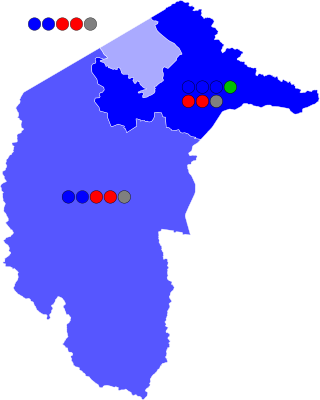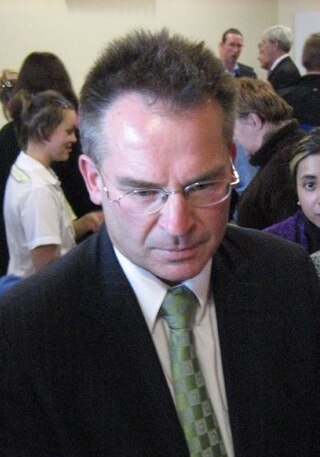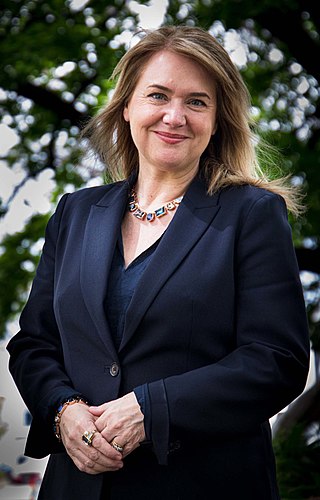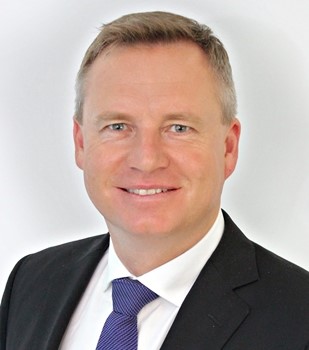Related Research Articles

The Tasmanian Greens are a political party in Australia which developed from numerous environmental campaigns in Tasmania, including the flooding of Lake Pedder and the Franklin Dam campaign. They form a part of the Australian Greens.

William Edward Felix Hodgman is an Australian diplomat and former politician who has been the High Commissioner of Australia to Singapore since February 2021. He was the 45th Premier of Tasmania and a member for the Division of Franklin in the Tasmanian House of Assembly from the 2002 state election until his resignation in January 2020. He became premier following the 2014 state election, having been Leader of the Opposition since 2006. He was re-elected to a second term in government following victory in the 2018 state election.

Elections to the Australian Capital Territory Legislative Assembly were held on Saturday, 21 February 1998. The incumbent Liberal Party, led by Kate Carnell, was challenged by the Labor Party, led by Wayne Berry. Candidates were elected to fill three multi-member electorates using a single transferable vote method, known as the Hare-Clark system. The result was another hung parliament. However the Liberals, with the largest representation in the 17-member unicameral Assembly, formed Government with the support of independents Michael Moore, Paul Osborne, and Dave Rugendyke. Carnell was elected Chief Minister at the first sitting of the fourth Assembly on 19 March 1998.

Elections to the Australian Capital Territory Legislative Assembly were held on Saturday, 20 October 2001. The incumbent Liberal Party, led by Gary Humphries, was challenged by the Labor Party, led by Jon Stanhope. Candidates were elected to fill three multi-member electorates using a single transferable vote method, known as the Hare-Clark system. The result was another hung parliament. However Labor, with the largest representation in the 17-member unicameral Assembly, formed Government with the support of the ACT Greens and Democrats. Stanhope was elected Chief Minister at the first sitting of the fifth Assembly on 12 November 2001. The election was conducted by the ACT Electoral Commission and was the first time in Australia's history that an electronic voting and counting system was used for some, but not all, polling places.

Elections to the Australian Capital Territory Legislative Assembly were held on Saturday, 16 October 2004. The incumbent Labor Party, led by Jon Stanhope, was challenged by the Liberal Party, led by Brendan Smyth. Candidates were elected to fill three multi-member electorates using a single transferable vote method, known as the Hare-Clark system. The result was a clear majority of nine seats in the 17-member unicameral Assembly for Labor. It marked the first and so far only time in the history of ACT self-government that one party was able to win a majority in its own right. Stanhope was elected Chief Minister at the first sitting of the sixth Assembly on 4 November 2004. The election was conducted by the ACT Electoral Commission and was the second time in Australia's history that an electronic voting and counting system was used for some, but not all, polling places, expanding on the initial trial of the system at the 2001 ACT election.

Elections to the Australian Capital Territory Legislative Assembly were held on Saturday, 18 October 2008. The incumbent Labor Party, led by Jon Stanhope, was challenged by the Liberal Party, led by Zed Seselja. Candidates were elected to fill three multi-member electorates using a single transferable vote method, known as the Hare-Clark system. The result was another hung parliament with Labor winning seven seats, the Liberals six seats and the Greens finishing with four seats, giving the Greens the balance of power in the 17-member unicameral Assembly. On 31 October 2008, after almost two weeks of deliberations, the Greens chose to support a Labor minority government. Consequently, Labor was re-elected to a third consecutive term of government in the ACT. Stanhope was elected Chief Minister at the first sitting of the seventh Assembly on 5 November 2008. The election was conducted by the ACT Electoral Commission.
This article provides information on candidates who stood for the 2006 Tasmanian state election. The election was held on 18 March 2006.

The 2009 Fremantle state by-election was held in the Western Australian Legislative Assembly district of Fremantle on 16 May 2009. It was triggered by the resignation of sitting member Jim McGinty.
The 2002 Tasmanian state election was held on 20 July 2002.

The 2010 Tasmanian state election was held on 20 March 2010 to elect members to the Tasmanian House of Assembly. The 12-year incumbent Labor government, led by Premier of Tasmania David Bartlett, won a fourth consecutive term against the Liberal opposition, led by Will Hodgman, after Labor formed a minority government with the support of the Greens.
This article provides information on candidates who stood for the 2010 Tasmanian state election.

The 2014 Tasmanian state election was held on 15 March 2014 to elect all 25 members to the House of Assembly. The 16-year incumbent Labor government, led by the Premier of Tasmania Lara Giddings, sought to win a fifth consecutive term in government, but was defeated by the Liberal opposition, led by Opposition Leader Will Hodgman, in a landslide victory. Also contesting the election was the Greens led by Nick McKim. The Palmer United Party made a significant effort in the election.
Periodic elections for the Tasmanian Legislative Council were held on 7 May 2011. The three seats up for election were Launceston, held by retiring independent MLC Don Wing; Murchison, held by independent MLC Ruth Forrest; and Rumney, held by Labor MLC Lin Thorp. These seats were last contested in 2005.

The 2018 Tasmanian state election was held on 3 March 2018 to elect all 25 members of the Tasmanian House of Assembly.
This article provides information on candidates who stood at the 2014 Tasmanian state election, held on 15 March 2014.

Madeleine Ruth Ogilvie is an Australian lawyer and politician. She is a Liberal Party member of the Tasmanian House of Assembly representing the Division of Clark and is a minister in the Second Rockliff ministry

The 2021 Tasmanian state election was held on 1 May 2021 to elect all 25 members to the Tasmanian House of Assembly.
This article provides information on candidates who stood at the 2018 Tasmanian state election, which was held on 3 March 2018.
The Tasmanian Labor Party, officially known as the Australian Labor Party (Tasmanian Branch) and commonly referred to simply as Tasmanian Labor, is the Tasmanian branch of the Australian Labor Party. It has been one of the most successful state Labor parties in Australia in terms of electoral success.

The 2024 Tasmanian state election was held on 23 March 2024 to elect all 35 members to the House of Assembly.
References
- ↑ "2021 State election candidates: Bass". Tasmanian Electoral Commission. Retrieved 8 April 2021.
- ↑ "2021 State election candidates: Braddon". Tasmanian Electoral Commission. Retrieved 8 April 2021.
- ↑ "2021 State election candidates: Clark". Tasmanian Electoral Commission. Retrieved 8 April 2021.
- ↑ "Tasmanian Labor candidate Ben McGregor resigns from candidacy over 'inappropriate' text messages". ABC News. 7 April 2021. Retrieved 7 April 2021.
- ↑ "2021 State election candidates: Franklin". Tasmanian Electoral Commission. Retrieved 8 April 2021.
- ↑ "Tasmanian Liberal candidate who attended anti-lockdown rally resigns". ABC News. 31 March 2021. Retrieved 31 March 2021.
- ↑ "2021 State election candidates: Lyons". Tasmanian Electoral Commission. Retrieved 8 April 2021.